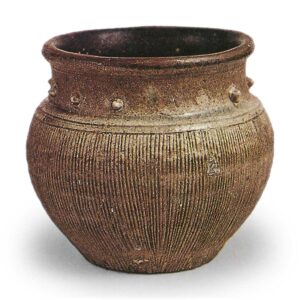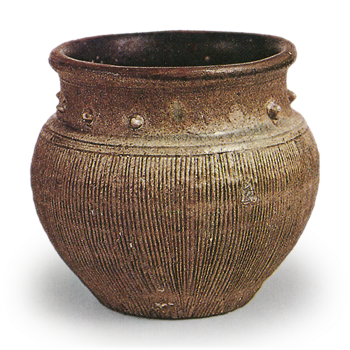
Excavated from Shichikyoku Kiln, Kitaoka-cho, Seto City, Aichi Prefecture, Japan
14th century
Height 7.6cm, Bore 7.2cm, Body 8.6cm, Bottom 4.6cm
A wide-mouthed tea caddy with a small protrusion at the mouth is called a “kokuza tea caddy,” and this is, needless to say, a copy of the Han-saku “sekiza” type. In Seto, several examples have been excavated from kilns of the Nanboku-cho period, including the Yamaji Tokyo and Shichikyoku kilns. The body of each of these examples is decorated with horizontal and vertical concentric circles. In the “Katsuragawa Jizo Ki” written in the Oei period (1592-1591), “Fukucha” is mentioned as imported ceramics, and “Ruisa” is also mentioned in the “Kimitai Kanjyocho Ki,” indicating that this type of tea container was established as a type of tea container from early times. This type of seating technique was also used for washing dishes, etc., and its prototype can be found in Song dynasty celadon porcelain. The oldest examples of this type of washing have been excavated from the Chagari kiln and clearly date back to the end of the Kamakura period (1185-1333), but none of the tea caddies date back to the Nanbokucho period (1392-1333).
This is the best example of a za-cha-irin (tea caddy). It is made of grandmother’s clay and water-ground, and has a rather thick but neat shape.
The interior is thinly glazed with black glaze. The seat and part of the shoulder are lightly glazed and have a light green color.



